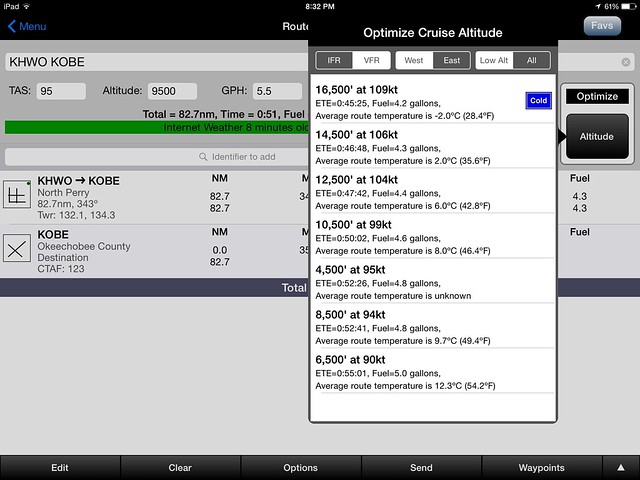narchee
Line Up and Wait
- Joined
- Sep 8, 2014
- Messages
- 722
- Display Name
Display name:
Long Blinker
Let's say you're in a piston turbo plane and have a wide range of altitudes to play with. In my experience the forecast upper winds and what I see seem to differ quite significantly in some cases. Also your TAS speed goes up for the same IAS so you have to take that in account.
I'm a bit of a fanatic in wanting to be at the most optimum altitude (it's the engineer in me) so I want to know what is the ACTUAL best altitude to be at.
This is the process I follow when going into a headwind (usually westbound):
I get a rough idea of how high I want to go from the forecast winds then add a nice margin to that (perhaps an additional 5000 feet). I then file for that altitude let's say FL220. I then depart and climb at a constant IAS. Let's say 110 knots. While climbing I take note of my GS. The GS will usually increase as I climb but at point it may stabilize then start to go down. The headwind will usually be increasing but so will the TAS so the GS depends on which one is "winning". Once I note that the GS has started to drop, I will then ask ATC for an amended altitude and go to the highest altitude that had the best GS that I had observed. Kind of complicated but I know then I'm at the most efficient altitude speed wise (I don't generally care about fuel burn). For the rest of the trip I then continue to monitor GS and either climb or descend based on what I'm seeing.
When flying with a tailwind I go as high as I can since then I have both TAS and the tailwind climbing so the optimal altitude is the highest I can get.
Kind of complicated I know but it keeps me something to do on an otherwise long boring flight
I'm a bit of a fanatic in wanting to be at the most optimum altitude (it's the engineer in me) so I want to know what is the ACTUAL best altitude to be at.
This is the process I follow when going into a headwind (usually westbound):
I get a rough idea of how high I want to go from the forecast winds then add a nice margin to that (perhaps an additional 5000 feet). I then file for that altitude let's say FL220. I then depart and climb at a constant IAS. Let's say 110 knots. While climbing I take note of my GS. The GS will usually increase as I climb but at point it may stabilize then start to go down. The headwind will usually be increasing but so will the TAS so the GS depends on which one is "winning". Once I note that the GS has started to drop, I will then ask ATC for an amended altitude and go to the highest altitude that had the best GS that I had observed. Kind of complicated but I know then I'm at the most efficient altitude speed wise (I don't generally care about fuel burn). For the rest of the trip I then continue to monitor GS and either climb or descend based on what I'm seeing.
When flying with a tailwind I go as high as I can since then I have both TAS and the tailwind climbing so the optimal altitude is the highest I can get.
Kind of complicated I know but it keeps me something to do on an otherwise long boring flight



